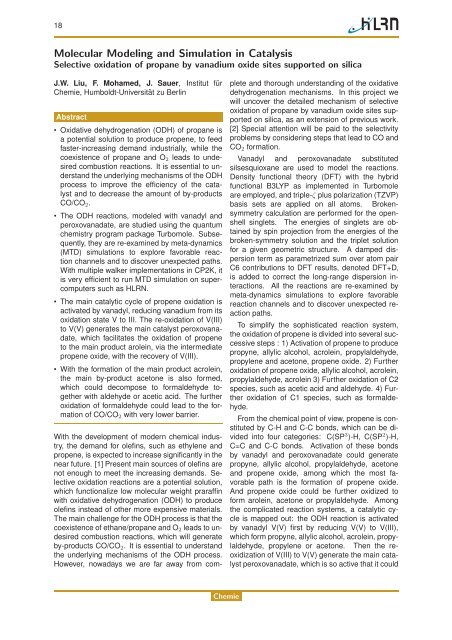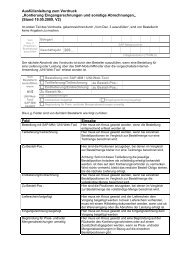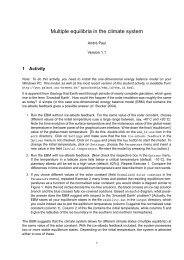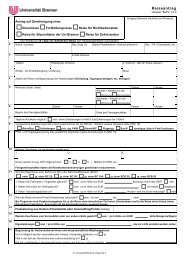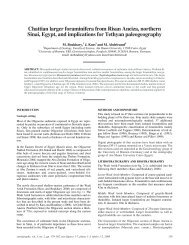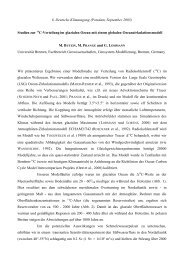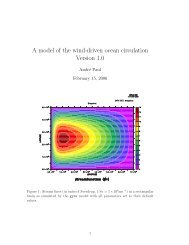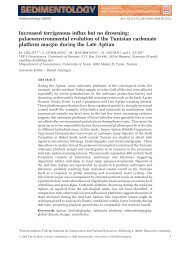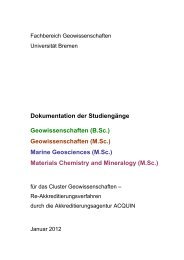Forschung im HLRN-Verbund 2011
Forschung im HLRN-Verbund 2011
Forschung im HLRN-Verbund 2011
- Keine Tags gefunden...
Sie wollen auch ein ePaper? Erhöhen Sie die Reichweite Ihrer Titel.
YUMPU macht aus Druck-PDFs automatisch weboptimierte ePaper, die Google liebt.
18Molecular Modeling and S<strong>im</strong>ulation in CatalysisSelective oxidation of propane by vanadium oxide sites supported on silicaJ.W. Liu, F. Mohamed, J. Sauer, Institut fürChemie, Humboldt-Universität zu BerlinAbstract• Oxidative dehydrogenation (ODH) of propane isa potential solution to produce propene, to feedfaster-increasing demand industrially, while thecoexistence of propane and O 2 leads to undesiredcombustion reactions. It is essential to understandthe underlying mechanisms of the ODHprocess to <strong>im</strong>prove the efficiency of the catalystand to decrease the amount of by-productsCO/CO 2 .• The ODH reactions, modeled with vanadyl andperoxovanadate, are studied using the quantumchemistry program package Turbomole. Subsequently,they are re-examined by meta-dynamics(MTD) s<strong>im</strong>ulations to explore favorable reactionchannels and to discover unexpected paths.With multiple walker <strong>im</strong>plementations in CP2K, itis very efficient to run MTD s<strong>im</strong>ulation on supercomputerssuch as <strong>HLRN</strong>.• The main catalytic cycle of propene oxidation isactivated by vanadyl, reducing vanadium from itsoxidation state V to III. The re-oxidation of V(III)to V(V) generates the main catalyst peroxovanadate,which facilitates the oxidation of propeneto the main product arolein, via the intermediatepropene oxide, with the recovery of V(III).• With the formation of the main product acrolein,the main by-product acetone is also formed,which could decompose to formaldehyde togetherwith aldehyde or acetic acid. The furtheroxidation of formaldehyde could lead to the formationof CO/CO 2 with very lower barrier.With the development of modern chemical industry,the demand for olefins, such as ethylene andpropene, is expected to increase significantly in thenear future. [1] Present main sources of olefins arenot enough to meet the increasing demands. Selectiveoxidation reactions are a potential solution,which functionalize low molecular weight praraffinwith oxidative dehydrogenation (ODH) to produceolefins instead of other more expensive materials.The main challenge for the ODH process is that thecoexistence of ethane/propane and O 2 leads to undesiredcombustion reactions, which will generateby-products CO/CO 2 . It is essential to understandthe underlying mechanisms of the ODH process.However, nowadays we are far away from completeand thorough understanding of the oxidativedehydrogenation mechanisms. In this project wewill uncover the detailed mechanism of selectiveoxidation of propane by vanadium oxide sites supportedon silica, as an extension of previous work.[2] Special attention will be paid to the selectivityproblems by considering steps that lead to CO andCO 2 formation.Vanadyl and peroxovanadate substitutedsilsesquioxane are used to model the reactions.Density functional theory (DFT) with the hybridfunctional B3LYP as <strong>im</strong>plemented in Turbomoleare employed, and triple-ζ plus polarization (TZVP)basis sets are applied on all atoms. Brokensymmetrycalculation are performed for the openshellsinglets. The energies of singlets are obtainedby spin projection from the energies of thebroken-symmetry solution and the triplet solutionfor a given geometric structure. A damped dispersionterm as parametrized sum over atom pairC6 contributions to DFT results, denoted DFT+D,is added to correct the long-range dispersion interactions.All the reactions are re-examined bymeta-dynamics s<strong>im</strong>ulations to explore favorablereaction channels and to discover unexpected reactionpaths.To s<strong>im</strong>plify the sophisticated reaction system,the oxidation of propene is divided into several successivesteps : 1) Activation of propene to producepropyne, allylic alcohol, acrolein, propylaldehyde,propylene and acetone, propene oxide. 2) Furtheroxidation of propene oxide, allylic alcohol, acrolein,propylaldehyde, acrolein 3) Further oxidation of C2species, such as acetic acid and aldehyde. 4) Furtheroxidation of C1 species, such as formaldehyde.From the chemical point of view, propene is constitutedby C-H and C-C bonds, which can be dividedinto four categories: C(SP 3 )-H, C(SP 2 )-H,C=C and C-C bonds. Activation of these bondsby vanadyl and peroxovanadate could generatepropyne, allylic alcohol, propylaldehyde, acetoneand propene oxide, among which the most favorablepath is the formation of propene oxide.And propene oxide could be further oxidized toform arolein, acetone or propylaldehyde. Amongthe complicated reaction systems, a catalytic cycleis mapped out: the ODH reaction is activatedby vanadyl V(V) first by reducing V(V) to V(III),which form propyne, allylic alcohol, acrolein, propylaldehyde,propylene or acetone. Then the reoxidizationof V(III) to V(V) generate the main catalystperoxovanadate, which is so active that it couldChemie


